This post may contain affiliate links. That means if you click and buy, I may receive a small commission. Please read my full disclosure policy for details.
COMMON PLANT DISEASES
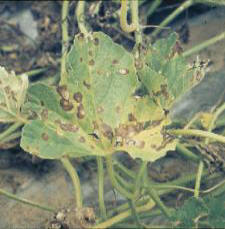
So maybe you haven’t found bugs and pests in your hydro garden, but other mysterious things are going on…
Aside from common plant pests, there are
several different types of common plant diseases that can threaten your new garden.
Among these plagues are mildew, molds, viruses, and algae. Most of them
are caused, as you might suspect, by high humidity and stale air.
Excessive
humidity is the leading cause of fungus and mold outbreaks, so it pays
to keep an eye on the humidity level of your garden environment. Use a
hygrometer ($6 at Walmart) and check the RH (relative humidity)
periodically. You might think that a hot, humid atmosphere (like an
orchid house) might also be the best for your veggies, but that is not
the case. Hydroponic vegetable crops actually do best at a RH of 50-60%;
80% as a maximum.

You can reduce the humidity in your grow
area by using an air conditioner, and also an inexpensive fan to keep
the air circulating. It is best to see the leaves of your plants moving
very slightly, 24 hours per day. This flushes out stale air and helps to
prevent the formation of those dreaded mildews and molds, as well as other
common plant diseases.
Also
be careful not to over-water your plants, and make sure the media used
is draining well between feedings. Soggy plant media makes a great host
for disease and algae growth.
THE MOST COMMON PLANT DISEASES
Below we list the most common plant diseases you might find in your hydroponic garden:
GRAY MOLD (BOTRYTIS)
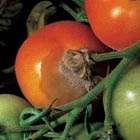
A sooty, grayish-white growth on the
leaves (kinda like hair or lint). This is the most common fungus caused
by excessive humidity, and is usually fatal once it takes hold. If you
catch it as a fresh outbreak, you may be able to fight it off. How?
- Take a soft, dry cloth and remove the mold from the leaves.
- Scour the garden for dead matter and debris and remove it.
- Decrease humidity and increase air circulation and ventilation.
POWDERY MILDEW
 |
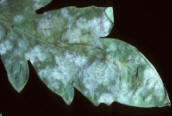 |
First appears as small white spots on
the tops of the leaves, but then progresses a fine, pale gray-white
powder, all over. Growth slows, leaves turn yellow and the plant dies.
Powdery mildew is caused by cool temps, dim light and high humidity. How
to treat this common plant disease?
- Decrease humidity
- Increase air circulation and ventilation
- Increase light intensity
- Consider one of the fungicides listed below
DAMPING OFF
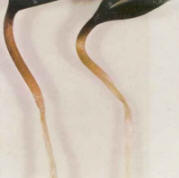
This common plant disease usually affects your
newly planted seedlings, and is caused by too-moist planting media. You
must keep those grow-cubes drained off, not just sitting in water.
Damping off first appears as a wet-looking dark stem. The seedling then
collapses at the "soil line", and falls over dead. There is no cure,
once damping-off strikes. So how do you prevent it?
- Use only sterile, fast draining media for your seedling nursery.
- Consider routine application of all-purpose fungicides below.
ALGAE

You know what this looks like; a
greenish tinge that covers the top of the plant media, and may infest
your nutrient vat, too. Algae is really not a serious problem, however
it is unsightly and signals to you that conditions may be a little too
moist in there.
Algae growth is caused by stagnant water, excessive
moisture, and light. You can prevent it from attacking your nutrient
solution by using only opaque tubing in your system (not clear). Cover
any ports in the nutrient reservoir with hatches or duck tape to keep
light out. Other measures that may help:
- If using fine, porous medium, like coco coir or perlite mixes, top each pot with 1-2" of leca stones to provide a
dry barrier. This not only holds down the lighter media, it helps prevent algae and fungus gnats. - Scrape off the algae and correct the overly-damp conditions that caused it.
- Sterilize your system between plantings with 10% bleach solution.
WILTS
![[wilt-disease] Verticullum Wilt and Fusarium Wilt [wilt-disease] Verticullum Wilt and Fusarium Wilt](https://www.hydroponics-simplified.com/images/wilt-disease.jpg)
[wilt-disease] Verticullum Wilt and
Fusarium Wilt- Wilt diseases start as small spots on the leaves of your
tomato, peppers or eggplants. The lower leaves start to curl up, dry out
and wilt. Sometimes, portions of the plant may wilt suddenly. You can
prevent these wilt viruses by using only fresh, clean medium for each
planting, and using resistant varieties of tomatoes (labelled V or F).
If
you do contract one of these common plant diseases, you cannot re-use the media, or
the wilts will just reappear in your new planting. You might want to try
treating the wilts with DCM Bio-Fungus, but honestly, it is best to
just get that diseased plant OUT of your hydro setup, and disinfect well
before starting your next new garden.
TOBACCO MOSAIC VIRUS
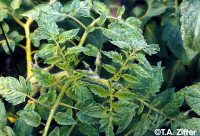
This virus remains on tobacco leaves
for years. It can be introduced to your garden by the hands of smokers.
It can afflict peppers, cucumbers, and tomato plants, and it is very
hard to eradicate if you are unlucky enough to contract this plague.
Prevention is the keyword here:
- Never allow smoking in your hydro grow room.
- Smokers must wash their hands thoroughly with soap and water before touching anything in your garden area.
- Even this might not prevent an infestation. Best to exclude smokers if you are fond of heirloom tomatoes. May be just the incentive they need to quit 🙂
Some relatively safe organic Fungicides:
You may need to resort to stronger measures to control these common plant diseases. These are fairly safe fungicides.
Please use our Amazon affiliate links to order:
Return From Common Plant Diseases to Pests & Plagues
RETURN TO HOME PAGE
New! Comments
Have your say about what you just read! Leave me a comment in the box below.

I have been searching your site and may others for information about mold. I bought a small hydroponic grower for up to 12 plants. I followed the directions and put seeds in it and they all got mold. I emptied everything out & through away the dirt sponges that came with it. I want to try again, but if I don’t understand how to combat the mold and change something, it will just happen again. Thought about cleaning everything and then trying. Ideas?